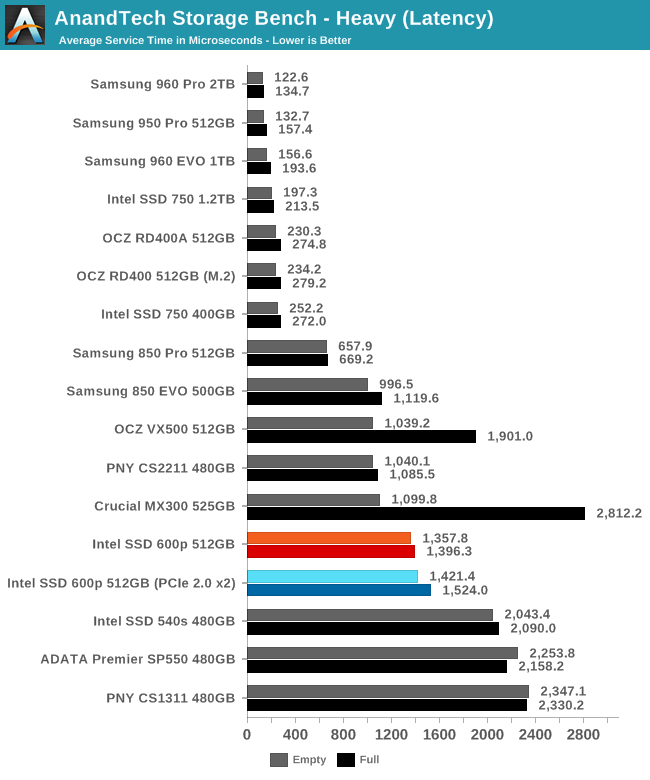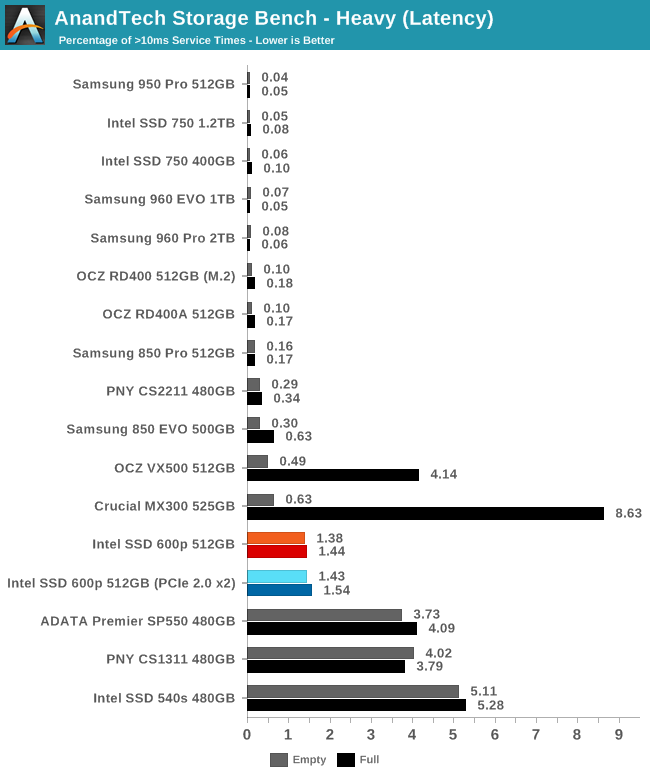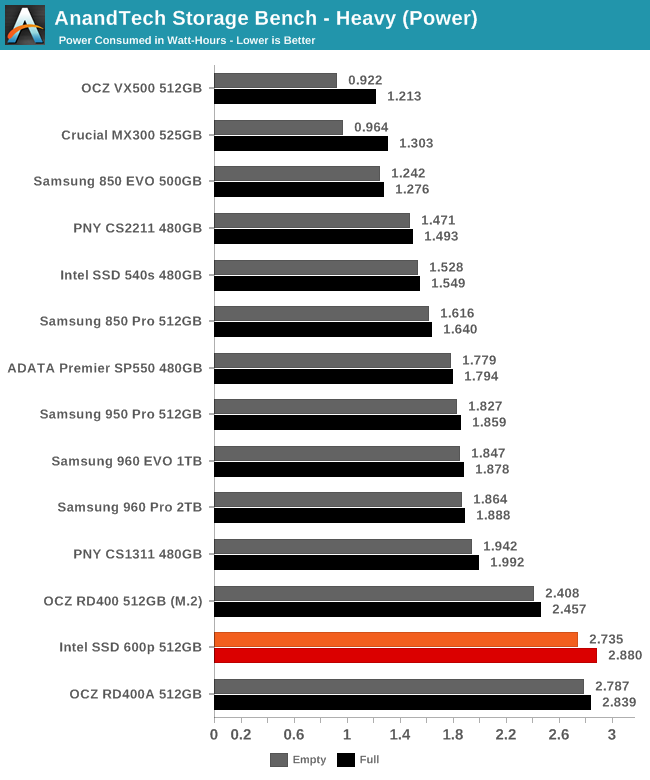The Intel SSD 600p (512GB) Review
by Billy Tallis on November 22, 2016 10:30 AM ESTAnandTech Storage Bench - Heavy
Our Heavy storage benchmark is proportionally more write-heavy than The Destroyer, but much shorter overall. The total writes in the Heavy test aren't enough to fill the drive, so performance never drops down to steady state. This test is far more representative of a power user's day to day usage, and is heavily influenced by the drive's peak performance. The Heavy workload test details can be found here.

It is quite clear that the 600p takes a very different approach to managing its 3D TLC than the Crucial MX300. The latter performed much better than most TLC drives when the Heavy test was run on an empty drive, but fell to last place when the test was conducted on a full drive. The 600p by contrast performed quite similarly in both scenarios due to its fixed-size SLC cache. Unfortunately, this means the 600p has no significant advantage over budget SATA SSDs on this test.

The 600p has lower average service times than the planar TLC SATA SSDs, but it isn't up to the level of the Samsung 850 EVO or MLC SATA SSDs.

The percentage of high-latency outliers shows that the 600p is in a category of its own, sitting above planar TLC SSDs that get thoroughly bogged down by the write-heavy test but not good enough to be lumped together with MLC SSDs.

The 600p is less efficient than any M.2 or SATA SSD on this test, and is only matched by the OCZ RD400A because the latter is doing its own 12V to 3.3V conversion instead of drawing directly from the 3.3V supply.










63 Comments
View All Comments
Billy Tallis - Thursday, November 24, 2016 - link
They're in Bench now.Flying Aardvark - Friday, November 25, 2016 - link
I have the 1TB 600P and love it. I bought it knowing full well it wasn't a benchmark king. Don't care, low QD performance has hardly improved for quite some time. But at the price, for a 5-year warranty with 0.3% failure rate per year was a no brainer over the 960 EVO for me.I can't get it to slow down or stutter in my case and if you can, you should probably step all the way up to the Intel 750, heatsink intact and all.
crazyowl - Sunday, November 27, 2016 - link
I'm not sure now to formulate this correctly so as not to hurt the reputation of the product, but there's been a report of a 600p burning a motherboard's traces when installed via a DeLonghi adapter card. Anandtech, what could you comment on that issue? Came across it in a review for the 600p at a respectable decent online shop.crazyowl - Sunday, November 27, 2016 - link
Sorry, it was DeLock, not DeLonghi. The latter seems to be a houseware brand.Billy Tallis - Sunday, November 27, 2016 - link
Our testing showed the 600p to be relatively power hungry by the standards of M.2 PCIe SSDs, but it most certainly wasn't drawing enough current to be a danger to any equipment that is capable of safely powering other M.2 PCIe SSDs. Whatever you read about was likely the result of either a manufacturing defect in the board that was supplying power to the M.2 drive, or the result of improper installation leading to a short circuit. I've killed a motherboard through the latter means, but it was only due to the modifications I've made to facilitate measuring PCIe card power consumption.Xajel - Monday, November 28, 2016 - link
I would love to have an NVMe SSD, sadly my system is old (ASUS P8Z77 ) so, it's not able to boot from NVMe.. although nothing is wrong with the chipset it can do it, but ASUS never released any BIOS update, there's some unofficial mod's which can enable this but there's no guarantee it will work or it will brick.el-loc0 - Monday, November 28, 2016 - link
@Anandtec: what equipment do you use to measure power consumption?Billy Tallis - Tuesday, November 29, 2016 - link
For PCIe SSDs, I use a riser card from Adex Electronics with current sense resistors on the 3.3V and 12V supply lines. For SATA SSDs, I use a multimeter spliced into the power cable to measure current directly.el-loc0 - Tuesday, November 29, 2016 - link
Thanks for quick reply, Billy. Do PCIe SSD Draw Power from both lines, 3.3 V and 12 V? Do you use a current clamp or how do you measure on the riser card? Which multimeter do you use?SanX - Thursday, December 1, 2016 - link
Did Intel pay for this BS review?